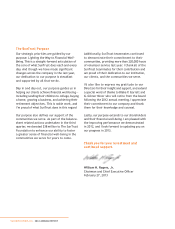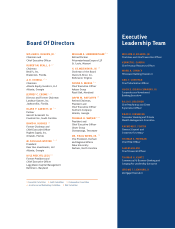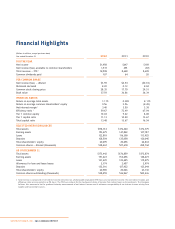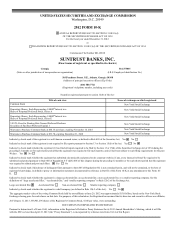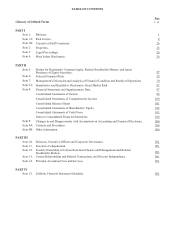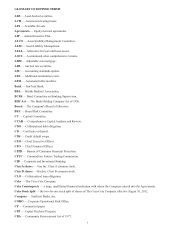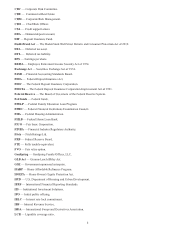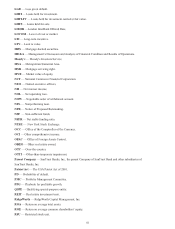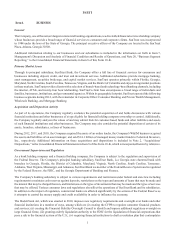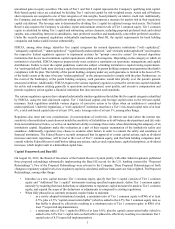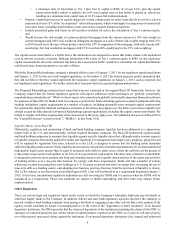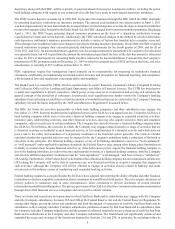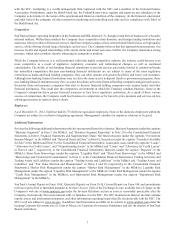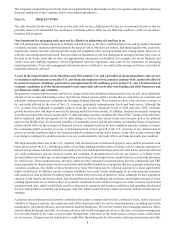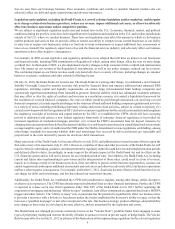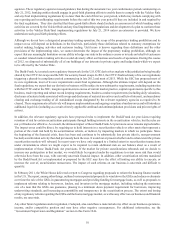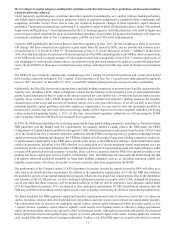SunTrust 2012 Annual Report Download - page 18
Download and view the complete annual report
Please find page 18 of the 2012 SunTrust annual report below. You can navigate through the pages in the report by either clicking on the pages listed below, or by using the keyword search tool below to find specific information within the annual report.2
the dissolution of the enterprise and submit that resolution plan to both the Board of Governors of the Federal Reserve and
the FDIC; (v) limiting debit card interchange fees; (vi) adopting certain changes to shareholder rights and responsibilities,
including a shareholder “say on pay” vote on executive compensation; (vii) strengthening the SEC's powers to regulate
securities markets; (viii) regulating OTC derivative markets; (ix) restricting variable-rate lending by requiring the ability to
repay to be determined for variable-rate loans by using the maximum rate that will apply during the first five years of a variable-
rate loan term, and making more loans subject to provisions for higher cost loans, new disclosures, and certain other revisions;
(x) changing the base upon which the deposit insurance assessment is assessed from deposits to, substantially, the average
consolidated assets minus equity, which likely increases the amount of deposit insurance assessment collected from SunTrust
Bank; and (xi) amending the Truth in Lending Act with respect to mortgage originations, including originator compensation,
minimum repayment standards, and prepayment considerations.
One of the more important changes instituted by the Dodd-Frank Act is twice-annual stress tests of the Company and its bank.
The performance of the Company under the stress tests and the comprehensive capital analysis and review (“CCAR”) dictate
capital actions the Company will be permitted by its regulators to take, such as dividends and share repurchases. Due to the
importance and intensity of the stress tests and the CCAR process, the Company has dedicated resources to comply with stress
testing requirements. These changes have profoundly impacted our policies and procedures and will likely continue to do so
as regulators adopt regulations going forward in accordance with the time table for enacting regulations set forth in the Dodd-
Frank Act.
Additionally, there have been a number of legislative and regulatory proposals that would have an impact on the operation of
financial holding companies and their bank and non-bank subsidiaries. Most recently, federal regulators have proposed new
capital requirements for financial institutions that include several changes to the way capital is calculated and how assets are
risk-weighted, informed in part by the Basel Committee on Banking Supervision's Basel III revised international capital
framework (“Basel III”). As proposed, the rule would have a profound effect on the Company's level of capital, as well as
the volatility of that capital, and would strongly influence the types of business the Company may pursue and how the Company
pursues business opportunities. Because the rule remains subject to change, and is subject to various interpretations in a number
of important aspects, we cannot predict whether or in what form these proposals may be adopted in the future and, if adopted,
what their effect will be on us. We do, however, provide an estimate of what our capital ratios would be in accordance with
the capital portion, as well as the risk-weighting of assets, based upon the proposed rule published by federal regulatory
agencies to adopt the Basel III international capital framework. As a result of the many unknowns and underlying assumptions
in the proposed rule, any estimate given is highly speculative and should be understood to not be authoritative guidance. See
our estimate of the proposed Basel III Tier 1 common equity ratio in the "Capital Resources" section of Item 7, "MD&A", in
this Form 10-K.
There are a number of obligations and restrictions imposed on bank holding companies and their depository institution
subsidiaries by federal law and regulatory policy that are designed to reduce potential loss exposure to the depositors of such
depository institutions and to the FDIC insurance fund in the event the depository institution becomes in danger of default or
is in default but are generally not intended for the protection of shareholders or other investors. For example, under a policy
of the Federal Reserve with respect to bank holding company operations, a bank holding company is required to serve as a
source of financial strength to its subsidiary depository institutions and commit resources to support such institutions in
circumstances where it might not do so absent such policy. The federal banking agencies have broad powers under current
federal law to require us to take prompt corrective action to resolve problems of insured depository institutions. The extent
of these powers depends upon whether the institutions in question are “well capitalized,” “adequately capitalized,”
“undercapitalized,” “significantly undercapitalized” or “critically undercapitalized” as such terms are defined under regulations
issued by each of the federal banking agencies. Under the Dodd-Frank Act, the FDIC has the authority to liquidate certain
financial holding companies that are determined to pose significant risks to the financial stability of the U.S. (“covered financial
companies”). Under this scenario, the FDIC would exercise broad powers to take prompt corrective action to resolve problems
with the covered financial company. The Dodd-Frank Act gives the Financial Stability Oversight Counsel (“FSOC”) substantial
resolution authority which may affect or alter the rights of creditors and investors in a resolution or distressed scenario. The
FDIC may make risk-based assessments of all bank holding companies with total consolidated assets greater than $50 billion
to recover losses incurred by the FDIC in exercising its authority to liquidate covered financial companies.
The Federal Reserve and the FDIC have issued substantially similar risk-based and leverage capital guidelines applicable to
U.S. banking organizations. Additionally, these regulatory agencies may require that a banking organization maintain capital
above the minimum levels, whether because of its financial condition or actual or anticipated growth. The Federal Reserve
risk-based guidelines define a tier-based capital framework. Tier 1 capital includes common shareholders' equity, trust preferred
securities, certain non-controlling interests and qualifying preferred stock, less goodwill (net of any qualifying DTL) and other
adjustments. Beginning in 2013, trust preferred securities will no longer be included in Tier 1 after a three-year phase-out.
Tier 2 capital consists of preferred stock not qualifying as Tier 1 capital, mandatorily convertible debt, limited amounts of
subordinated debt, other qualifying term debt, the allowance for credit losses up to a certain amount and a portion of the


